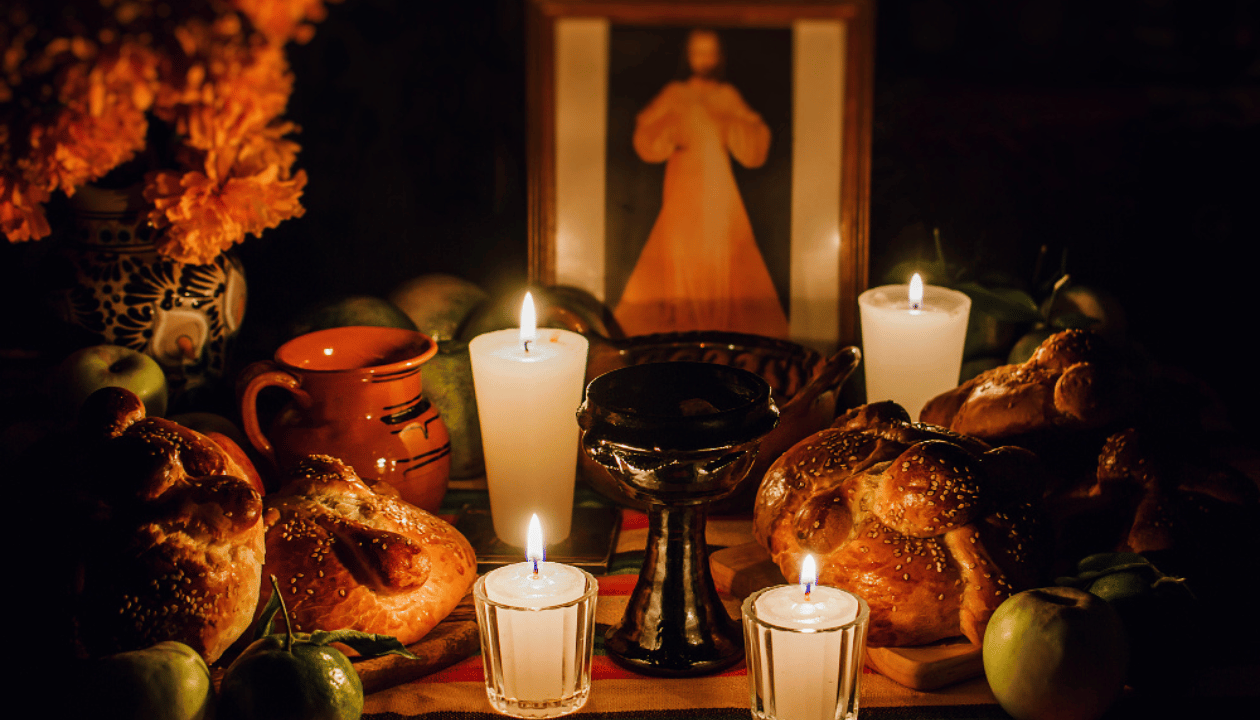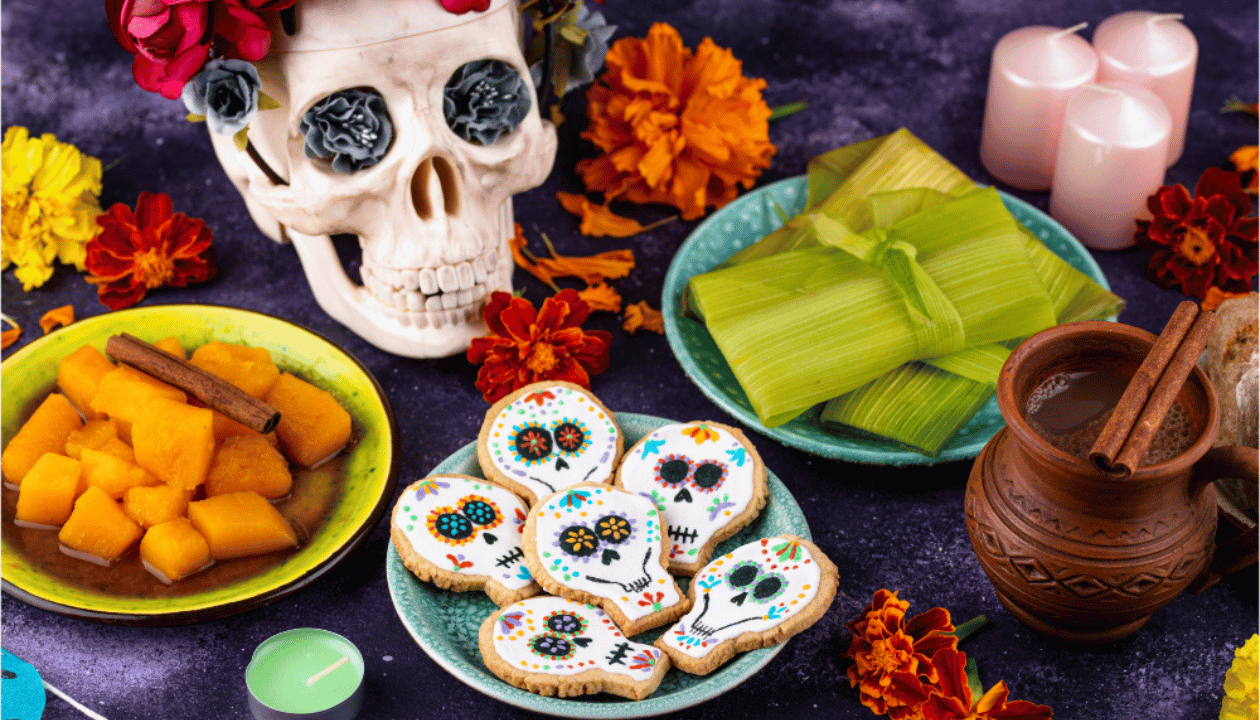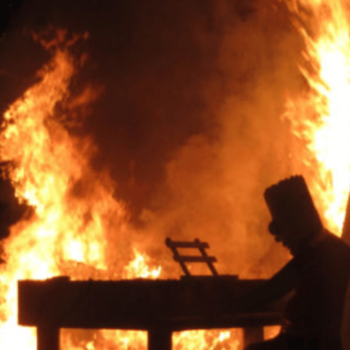

Internationally, All Saints’ Day and The Day of the Dead have become notable dates. However, they are most commonly celebrated in Spanish-speaking countries.
In some regions of Latin America and Spain, we can observe different variations of these events. Their respective customs, rituals, and even exquisite dishes may leave you curious about Hispanic gastronomy.
But what exactly are these celebrations about? Why do they call it All Saints’ Day? And, is The Day of the Dead and All Saints’ Day the same?
Don’t worry! Here’s everything you need to know to immerse yourself in the rich culture that comes with learning Spanish.
Ready? Let the celebrations begin!
Origin of All Saints’ Day
All Saints’ Day started in early Christian times. Pope Boniface IV introduced it in the 7th century. He dedicated a day to remembering all the martyrs. Later, Pope Gregory III and Pope Gregory IV changed it to honor all saints, not just martyrs. Pope Sixtus IV set it to November 1st.
This day is special in the Christian Church, especially in the Catholic Church. It is a public holiday in many countries. On this day, Christians, including Catholics and members of the Protestant and Anglican churches, remember all saints. They think about the holy lives and devout life of these saints. People often attend mass and light candles to show respect.
In the United Methodist Church, the day is not as well known. But they also think about saints on this day. The day is about giving God earnest gratitude for the saints. It reminds us of the saints’ labors and their rest in heaven.
Even in the Eastern Orthodox Church, they have a similar day. They celebrate it on the first Sunday after Pentecost. This day is also to remember all the holy men and women who have helped the church.
All Saints Day is not just about the well-known saints. It is also about the locally venerated saints and the faithful who have attained heaven. It’s a day when the whole Christian world remembers all the holy people who have passed away.
All Saints’ Day and The Day of the Dead, what’s the difference?
 Like All Saints’ Day, The Day of the Dead is also celebrated in many countries. But, they are not all the same celebrations. It is important to keep this in mind.
Like All Saints’ Day, The Day of the Dead is also celebrated in many countries. But, they are not all the same celebrations. It is important to keep this in mind.
All Saints’ Day origins can be traced back to religion, a Catholic event that was established around the 4th century.
The purpose of this date is to celebrate all the saints, as per its name. Every individual who has left his mark in the history of Catholicism and has gone through a canonisation process has a place in this celebration.
After the saints are celebrated on November 1st, November 2nd commemorates the deceased in a celebration called The Day of the Dead.
This intriguing event seeks to celebrate the people who are no longer with us on this earthly plane and, according to tradition, will later accompany us from the spiritual plane.
Fascinating, isn’t it? Now let’s get to know how they are celebrated in different countries.
Celebrations in Spanish-speaking countries
All Saints’ Day and The Day of the Dead have various interesting ways of being celebrated in different countries, such as:
South America
This region has been the least influenced by these celebrations. However, in countries such as Peru, Ecuador, Venezuela, and Colombia, some of the traditions are still maintained.
On All Saints’ Day, people usually go to church to attend a mass dedicated to this celebration. On The Day of the Dead, people visit their deceased relatives in the cemetery to bring them flowers and pray for their souls.
Central America
 Going further into the center, All Saints’ Day and The Day of the Dead takes on a little more importance, and in countries such as Guatemala and Nicaragua, they are celebrated in style.
Going further into the center, All Saints’ Day and The Day of the Dead takes on a little more importance, and in countries such as Guatemala and Nicaragua, they are celebrated in style.
These countries commemorate All Saints’ Day with masses and altars in their homes. On The Day of the Dead in Nicaragua, people go to the cemeteries and sleep near the graves of their relatives. Also, they bring flowers and other offerings on the visit.
Unlike Nicaragua, in Guatemala, no one sleeps on the graves. In this country, they visit the cemetery and raise golden kites, which symbolize communication between the afterlife and the earthly world.
But… Would you stay overnight in the cemetery? It is undoubtedly an interesting way to celebrate this day.
North America
Whilst Halloween reigns supreme in the United States, The Day of the Dead is also honoured throughout Mexico.
Even though they also celebrate All Saints’ Day, it is not nearly as important as November 2nd.
This special day is celebrated in Mexico with great offerings, photos, and objects that remember the deceased. Of course, the food is not far behind, and the banquets are laden with tamales, atole, mole, bread, and fruits, but it is the sweets that steal the show.
Pan de Muerto is undoubtedly the most widely used dessert for this date. This bread is moulded in the shape of a doughnut and is decorated with painted skulls and bones. The dish is usually accompanied by calabaza en tacha, calaveritas de chocolate y amaranto, and dulce de tejocote.
This date is so important for Mexicans that not only do they remember their deceased humans, but they also make altars for their deceased pets. Many times you can see offerings for family cats or dogs.
This is a touching celebration that is worth experiencing, even once in a lifetime.
Spain
 As with the other countries, Spain is also surrounded by traditions to celebrate these special days.
As with the other countries, Spain is also surrounded by traditions to celebrate these special days.
While some of the most general customs are visiting cemeteries and bringing flowers to the deceased, they also celebrate other unique traditions.
One of these is the screening of José Zorrilla’s play, “Don Juan Tenorio”. The theaters fill up to see this famous play on both November 1st and the day preceding it.
Of course, the food is not lacking, but it is again the sweets that steal the show. Between buñuelos de viento, huesos de santo and dulce de membrillo, the table is filled and shared with family and friends.
The drinks are not left behind, and the nights close with nostalgic toasts in honor of the saints and the dead.
Cheers!
Get ready to celebrate these dates with Spanish Express!
Ready to visit these countries and celebrate All Saints’ Day and The Day of the Dead? Then it’s time to learn Spanish with Spanish Express and experience this adventure in style!
There is no better way to immerse yourself in a culture than to learn its language.
Imagine celebrating the Day of the Dead in Mexico and understanding this celebration in their language? Or going to the theater in Spain and enjoying “Don Juan Tenorio” in its original language?
When you speak more than one language, the adventures become almost infinite as the fascinating experiences you can have expand.
Learn Spanish with us from the comfort of your home with our Spanish Online Programs. Choose the Spanish course that best suits your needs, and have the General Spanish Courses and the Exam Preparation Courses at your disposal.
Both can be easily integrated into your daily routines and, before you know it, you will be enjoying All Saints’ Day and The Day of the Dead from one of these countries.
What is the difference between All Souls Day and All Saints Day?
All Saints’ Day, observed by the Catholic Church and the Eastern Orthodox Church, celebrates all the saints, including those not officially canonized. Souls Day, on November 2, specifically commemorates the faithful departed, offering prayers for their souls.
What day is the Catholic All Saints’ Day?
In the Roman Catholic Church, All Saints’ Day is always on November 1. This day is a holy day of obligation, where Catholics honor all the saints, the holy martyrs, from the blessed Virgin Mary to the least known holy men.
Is All Saints’ Day the same date every year?
Yes, All Saints’ Day, a Christian celebration acknowledged by the Catholic Church and many Protestant churches, is on November 1 every year. It’s a day to remember all the saints, known and unknown.
Is All Saints’ Day the same as Halloween?
No, All Saints’ Day, celebrated by the Catholic Church and other Christian denominations, is not the same as Halloween. All Hallows Eve, or Halloween, is on October 31, marking the start of a three-day observance dedicated to remembering the dead, including saints (hallows), martyrs, and all the faithful departed.
What is All Saints’ Day, and why do we celebrate it?
All Saints’ Day is a significant feast in the Christian Church, especially the Catholic Church, to honor all saints and martyrs, known and unknown. Celebrated on November 1, it’s a time for giving God earnest gratitude for the exemplary lives and virtues of all His saints.
Is All Saints’ Day a Catholic holy day?
Yes, All Saints’ Day is a major holy day in the Catholic Church, also recognized by the Eastern Orthodox and many Protestant churches. It’s a day for remembering and honoring all the saints in the Christian faith.
What is the spiritual meaning of All Saints’ Day?
The spiritual meaning of All Saints’ Day, a significant day in Christian history, is to commemorate and seek inspiration from all the saints of the Christian Church. It’s a day to reflect on the holy lives and devout life led by these saints.
What is the Catholic belief of All Saints’ Day?
The Catholic belief about All Saints’ Day is that it’s a day to honor all the saints and martyrs, from the apostles to the least known holy figures. It’s a time for remembering their sacrifices and celebrating their contributions to the faith.
What is the meaning of Hallow day?
Hallow day refers to All Saints’ Day, a holy day in the Christian Church where all the saints (‘hallows’) are honored. It’s part of the triduum of Allhallowtide, which includes All Hallows Eve (Halloween), All Saints’ Day, and All Souls Day.
What is All Hallows Eve and All Saints’ Day?
All Hallows Eve (Halloween) and All Saints’ Day are part of the Allhallowtide period in the Christian calendar. While Halloween is more secular, All Saints’ Day, on November 1, is a religious observance in the Christian Church to honor all saints.
What is All Saints’ Day All Hallows Eve?
All Saints’ Day, following All Hallows Eve (Halloween), is a Christian feast day observed by the Catholic Church and other Christian denominations to honor all saints, both known and unknown.
What does the Roman Catholic church term All Hallows mean?
In the Catholic Church, ‘All Hallows’ refers to all the holy saints. All Hallows Eve, the eve before All Saints’ Day, marks the beginning of a three-day period dedicated to remembering all saints and the departed.
Why is All Saints’ Day on November 1?
All Saints’ Day is on November 1, as established by the Catholic Church under Pope Gregory III and Pope Gregory IV. It’s a day to honor all saints and martyrs in the Christian faith, a tradition that has been part of Christian history for centuries.
Is Nov 1 All Saints’ Day or All Souls Day?
November 1 is All Saints’ Day, a day dedicated to all saints in the Christian Church, particularly observed by the Catholic and Eastern Orthodox Churches. It is different from All Souls Day, which is on November 2 and focuses on praying for all departed souls.




